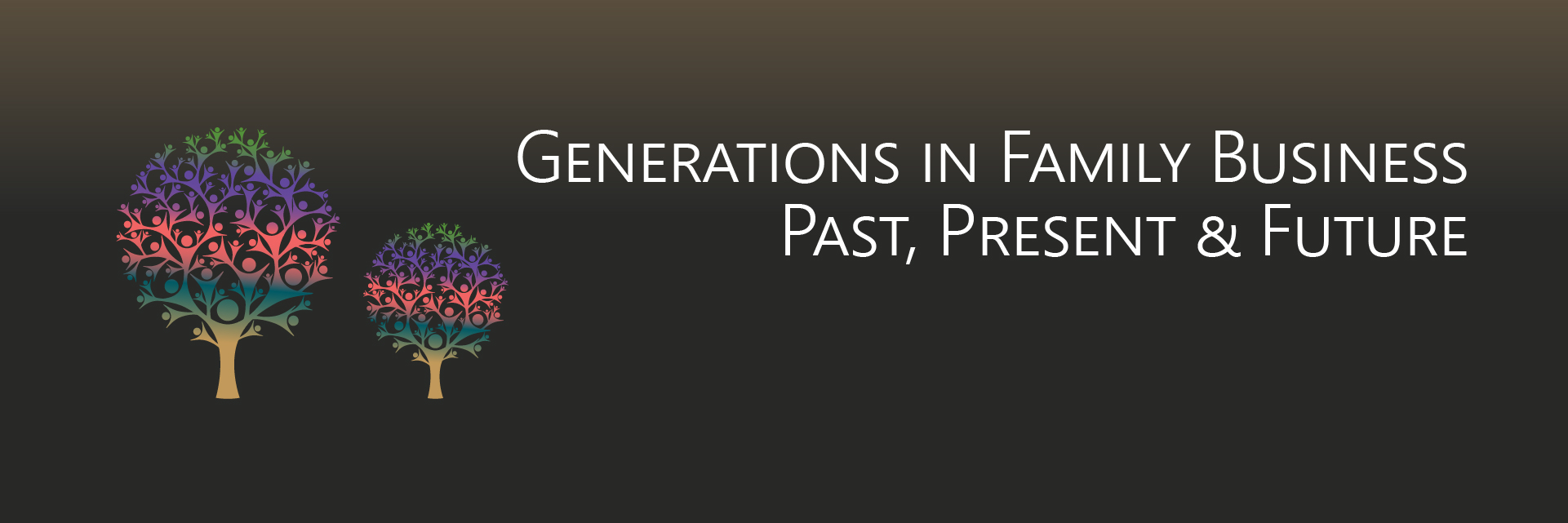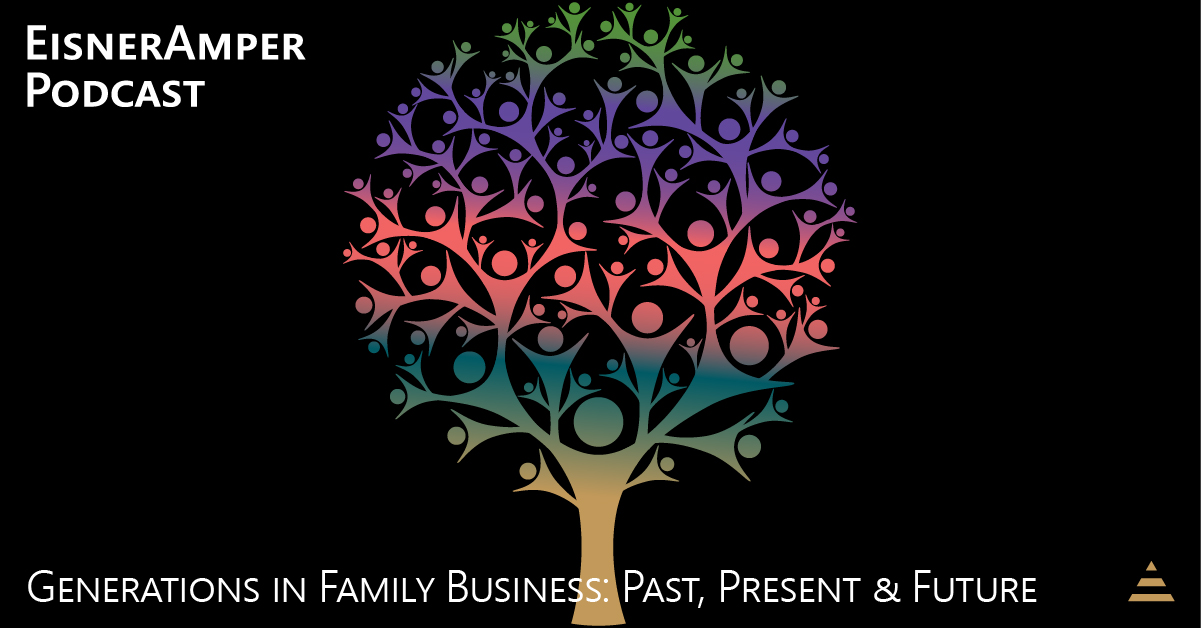
Succession Planning Process: Transition & Exit Strategy
- Published
- Oct 18, 2019
- Share
Matt Kerzner and Tim Schuster discuss the first step in the process for succession planning, the Transition/Exit Strategy.
Transcript
Tim Schuster: Welcome to our podcast for “Generations in Family, Business: Past, Present, and Future.” Our hosts for this podcast are myself, Tim Schuster, a senior manager in EisnerAmper’s Center for Family Business Excellence. And, as always, with us today is…
Matt Kerzner: Matt Kerzner and I'm a director in the Center for Family Business Excellence.
TS: Hi Matt. It's good to see you. So this is a great series that we're talking about. We’re taking our listeners through how we would actually set up succession planning. And just to remind our listeners, our last podcast, we actually recorded the six steps. So Matt, would you mind briefly reiterating again what the six steps are in the process?
MK: Sure. The first step, and that's what we're going to dive into today, is the transition exit strategy. And the second step is governance. How do you develop governance? And then we get into growth and valuation enhancement. You want to grow the business. The idea you want to create the sustainability, and then we do execution and accountability. How are you holding your family and yourself accountable through this process? And then it's really developing your bench strength, leadership development, and then the actual transaction, the succession. It's the process, right? So today we're going to get into transition exit strategies.
TS: So this is the first step in the process. I always feel like this is super important. In a lot of instances, businesses don't take the time to think about this. Really, you should have some form of exit strategy, so let's talk about that.
MK: It’s interesting you said exit strategy because it is transition exit strategy. But just transition planning or succession planning doesn't necessarily mean exiting the business. Changing your role. It could go from CEO to board chair. It could go from just being a board member. I don't want people to feel succession planning means you're out of the business. When you're an owner or the CEO, what do you want to do when you get to the next phase? It's really the big piece. So really the first part of the transition planning is you’ve got to define your emotional and financial readiness to leave the business. Or I should say, leave the role that you're currently in. And the key thing here is to understand your options for exiting the business. What is it worth? Does anybody really want it? Do they want to exit? They need to understand.
TS: And it's interesting that you talk about that, Matt, because I get this a lot with my clients. It's a matter of thinking of mortality. That’s what people relate that to. They're like, “oh my gosh, it's the end of the road,” but it's getting out of that mindset. I'm the CEO, but I can actually just be on the board and still be, not day to day, but just really involved for high-level purposes.
MK: Or strategy. It’s amazing you used the word mortality and that is the biggest hurdle for CEOs or owners of family businesses to really grapple with, because the sands of time keep going and when people think about the next phase of their lives, it's very difficult for them. Putting together this transition plan, and I work with owners and CEOs and we talk succession. I use, let's say, December 31 is your last day. When I first start my coaching or dialogue, I'm say, “what does January 1 look like for you?” And we really start this process early to help build that next phase of life. If they do it properly, it's an easy transition. If not, there's some grieving that goes on.
TS: Which would be something you want to try to avoid. It's interesting, Matt, have you had an instance where you actually spoke to an owner where they said I don't even know what January 1 looks like? And, if you had, how did you help them bridge that gap and say let's get to that point?
MK: Perfect question. When we get into the transition conversation, the first thing I like to say is, okay, what does that next phase look like? Do you sit on other boards? Do you volunteer? Do you give back to the community? What are your passions? Do you have a bucket list? I can keep going. I brainstorm for them to put their ideas down from their brain to paper. And that's goal planning, and we put some goals together. I always say timing and planning are everything.
And the worst thing that can happen is people reach out to family advisors two months before they retire. You need a little more time than that. I actually think three to five years is actually the right planning process, not just to find, and I’m going to get into this in later podcasts, the right candidate, either family or non-family member to take over in the succession planning process. Do some brainstorming of what are the passions of that leader. Some family-owned businesses and CEOs have been in this position for 20 or 30 years. They're institutionalized. It’s a fun activity. It's a fun exercise. It's a little scary, but if it's done early enough and you really put this plan together, it changes the whole scope of the process.
TS: Absolutely. Another area that we discussed, Matt, is our strategic roadmap. How can we link this first phase here to the strategic growth?
MK: Great question, Tim. We get into the strategic roadmap and we start getting into what are the family's mission, vision and values or the business’ mission, vision and values. We start thinking about a CEO or an owner transitioning the business to either a family member, the next generation or a sibling or to a non-family member, you really want to make sure you have a foundational setting of what I call the compass to move the organization in the family forward. What is the mission? What are the values? What do you want to be in the next phase of this process? And what are the goals that you want to accomplish to actually transition and change your role?
One of the things we talked about is growing the business, operating efficiency, and that's very important to set up the next generation from going to entrepreneurial to durability. It's a phase that we talk about in business. I'm thinking people development and again it's the person who's going to be transitioning. What does it look like for them? What does the bench strength look like? Who are you selecting in this process? When you start thinking about the transition process, how is it linked to the strategic roadmap and what are the goals? What do you need to do to set up the business for the future? What are the operating efficiencies that you need to put in place to be successful? I always say when you're an owner of the business, and we talked about this in the past, how many hats do you actually wear?
I always say when I talk to my clients, if you're looking to exit the business because you work from rise up to fall down, how many hats do you wear? It's not a one-for-one replacement. How many people do you need to replace yourself with? If you're an entrepreneurial small business, not only are you the owner and the CEO, but you can also be the CFO and the controller, HR, and so forth. That's a really critical piece. Also when it gets into another piece here that is not truly linked to the strategic roadmap, but this is why you want to start early enough if you're looking not to sell the business and transition it, how much do you have for retirement? A lot of times family business owners, and this is a real statistic, actually only have about $40,000 saved for retirement because the rest of the money is actually tied up in the business: inventory, real estate, and they’re constantly reinvesting. It's very scary at times when they want to transition, but they can't.
TS: That's a position we don't want anyone to ever be in.
MK: This is why I say three to five years is a great opportunity because you can get your house in order.
TS: Matt, thank you so much for the useful information as always. And thank you for listening to “Generations in Family Business: Past, Present, and Future” as part of the EisnerAmper podcast series. If you have any questions or if there's a topic you'd like us to cover, email us at contact@eisneramper.com. Visit eisneramper.com for more information on this and a host of other topics. We look forward to have you listen in on our next EisnerAmper podcast.
Also Available On
More in this Series

Succession Planning Process: Roadmap to Successful Succession

Succession Planning Process: Governance

Succession Planning Process: Growth and Values

Succession Planning Process: Execution & Accountability

Succession Planning Process: Leadership & Development
What's on Your Mind?
Start a conversation with Timothy
Receive the latest business insights, analysis, and perspectives from EisnerAmper professionals.












